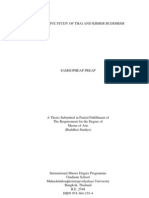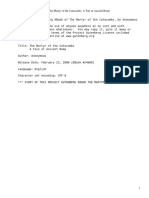Mohenjo Daro
Mohenjo Daro
Uploaded by
ayandasmtsCopyright:
Available Formats
Mohenjo Daro
Mohenjo Daro
Uploaded by
ayandasmtsOriginal Description:
Copyright
Available Formats
Share this document
Did you find this document useful?
Is this content inappropriate?
Copyright:
Available Formats
Mohenjo Daro
Mohenjo Daro
Uploaded by
ayandasmtsCopyright:
Available Formats
Mohenjo-daro
Mohenjo-daro
Mohenjo-daro
( Urdu) ( Sindhi)
The excavated ruins of Mohenjo-daro in present-day Sindh, Pakistan.
Shown within Pakistan Location Coordinates Type Sindh, Pakistan 271945N 680820E Settlement History Founded Abandoned Cultures 26th century BCE 19th century BCE Indus Valley Civilization UNESCO World Heritage Site Official name: Archaeological Ruins of Mohenjo-daro Type Criteria Designated Cultural ii, iii 1980 (4th session) [1]
Coordinates: 271945N 680820E [1]
ReferenceNo. 138 [2] State Party Region Pakistan Asia-Pacific
Mohenjo-daro
Location of Mohenjo-daro within the Pakistani province of Sindh. Mohenjo-daro (IPA: [mun do do], Urdu: , Sindhi: , lit. Mound of the Dead; English pronunciation: /mohn.doHelp:IPA for English#Keyd.ro/), is an archeological site in the province of Sindh, Pakistan. Built around 2600 BCE, it was one of the largest settlements of the ancient Indus Valley Civilization, and one of the world's earliest major urban settlements, contemporaneous with the civilizations of ancient Egypt, Mesopotamia, and Crete. Mohenjo-daro was abandoned in the 19th century BCE, and was not rediscovered until 1922. Significant excavation has since been conducted at the site of the city, which was designated a UNESCO World Heritage Site in 1980.[] However, the site is currently threatened by erosion and improper restoration.[3]
Name
Mohenjo-daro, the modern name for the site, simply means Mound of the Dead in Sindhi. The city's original name is unknown, but analysis of a Mohenjo-daro seal suggests a possible ancient Dravidian name, Kukkutarma ("the city [-rma] of the cockerel [kukkuta]").[4] Cock-fighting may have had ritual and religious significance for the city, with domesticated chickens bred there for sacred purposes, rather than as a food source.[5]
Location
Mohenjo-daro is located in the Larkana District of Sindh, Pakistan,[6] on a Pleistocene ridge in the middle of the flood plain of the Indus River Valley, around 28 kilometres (17mi) from the town of Larkana. The ridge was prominent during the time of the Indus Valley Civilization, allowing the city to stand above the surrounding plain, but the flooding of the river has since buried most of the ridge in deposited silt. The site occupies a central position between the Indus River and the Ghaggar-Hakra River. The Indus still flows to the east of the site, but the riverbed of the Ghaggar-Hakra on the western side is now dry.[7]
Historical context
Location of Mohenjo-daro in the Indus Valley Mohenjo-daro was built in the 26th century BCE.[8] It was one of the and extent of Indus Valley Civilization (green). largest cities of the ancient Indus Valley Civilization, also known as the Harappan Civilization,[9] which developed around 3000 BCE from the prehistoric Indus culture. At its height, the Indus Civilization spanned much of what is now Pakistan and North
India, extending westwards to the Iranian border, south to Gujarat in India and northwards to an outpost in Bactria, with major urban centers at Harappa, Mohenjo-daro, Lothal, Kalibangan, Dholavira and Rakhigarhi. Mohenjo-daro
Mohenjo-daro was the most advanced city of its time, with remarkably sophisticated civil engineering and urban planning.[10] When the Indus civilization went into sudden decline around 1900 BCE, Mohenjo-daro was abandoned.[8][11]
Rediscovery and excavation
The ruins of the city remained undocumented for over 3,700 years, until their discovery in 1922 by Rakhaldas Bandyopadhyay, an officer of the Archaeological Survey of India.[8] He was led to the mound by a Buddhist monk, who reportedly believed it to be a stupa. In the 1930s, major excavations were conducted at the site under the leadership of John Marshall, D. K. Dikshitar and Ernest Mackay.[] Further excavations were carried out in 1945 by Ahmad Hasan Dani and Mortimer Wheeler. The last major series of excavations were conducted in 1964 and 1965 by Dr. George F. Dales. After this date, excavations were banned due to weathering damage to the exposed structures, and the only projects allowed at the site since have been salvage excavations, surface surveys, and conservation projects. However, in the 1980s, German and Italian survey groups led by Dr. Michael Jansen and Dr. Maurizio Tosi used less invasive archeological techniques, such as architectural documentation, surface surveys, and localized probing, to gather further information about Mohenjo-daro.[]
Architecture and urban infrastructure
Mohenjo-daro has a planned layout based on a street grid of rectilinear buildings. Most were built of fired and mortared brick; some incorporated sun-dried mud-brick and wooden superstructures. The sheer size of the city, and its provision of public buildings and facilities, suggests a high level of social organization. At its peak of development, Mohenjo-daro could have housed around 35,000 residents. The city is divided into two parts, the so-called Citadel and the Lower City. The Citadel a mud-brick mound around 12 metres (39ft) high is known to have supported public baths, a large residential structure designed to house 5,000 citizens, and two large assembly halls.
View of the site, showing an ordered urban layout.
The city had a central marketplace, with a large central well. Individual households or groups of households obtained their water from smaller wells. Waste water was channeled to covered drains that lined the major streets. Some houses, presumably those of wealthier inhabitants, include rooms that appear to have been set aside for bathing, and one building had an underground furnace (known as a hypocaust), possibly for heated bathing. Most houses had inner courtyards, with doors that opened onto side-lanes. Some buildings had two stories. In 1950, Sir Mortimer Wheeler identified one large building in Mohenjo-daro as a "Great Granary". Certain wall-divisions in its massive wooden superstructure appeared to be grain storage-bays, complete with air-ducts to dry the grain. According to Wheeler, carts would have brought grain from the countryside and unloaded them directly into the bays. However, Jonathan Mark Kenoyer noted the complete lack of evidence for grain at the "granary", which, he argued, might therefore be better termed a "Great Hall" of uncertain function.[11] Close to the "Great Granary" is a large and elaborate public bath, sometimes called the Great Bath. From a colonnaded courtyard, steps lead down to the brick-built pool, which was waterproofed by a lining of bitumen. The pool measures 12 metres (39ft) long, 7 metres (23ft) wide and 2.4 metres (7.9ft) deep. It may have been used for religious purification. Other large buildings include a "Pillared Hall", thought to be an assembly hall of some kind, and the so-called "College Hall", a complex of buildings comprising 78 rooms, thought to have been a priestly residence. Mohenjo-daro had no circuit of city walls, but was otherwise well fortified, with guard towers to the west of the main settlement, and defensive fortifications to the south. Considering these fortifications and the structure of other
Mohenjo-daro major Indus valley cities like Harappa, it is postulated that Mohenjo-daro was an administrative center. Both Harappa and Mohenjo-daro share relatively the same architectural layout, and were generally not heavily fortified like other Indus Valley sites. It is obvious from the identical city layouts of all Indus sites that there was some kind of political or administrative centrality, but the extent and functioning of an administrative center remains unclear. Mohenjo-daro was successively destroyed and rebuilt at least seven times. Each time, the new cities were built directly on top of the old ones. Flooding by the Indus is thought to have been the cause of destruction.
Notable artifacts
Numerous objects found in excavations at Mohenjo-daro include seated and standing figures, copper and stone tools, carved seals, balance-scales and weights, gold and jasper jewellery, and children's toys.[12]
Dancing Girl
A bronze statuette dubbed the "Dancing Girl", 10.8 centimetres (4.3in) high and some 4,500 years old, was found in Mohenjo-daro in 1926. In 1973, British archaeologist Mortimer Wheeler described the item as his favorite statuette: "There is her little Balochi-style face with pouting lips and insolent look in the eyes. She's about fifteen years old I should think, not more, but she stands there with bangles all the way up her arm and nothing else on. A girl perfectly, for the moment, perfectly confident of herself and the world. There's nothing like her, I think, in the world." John Marshall, another archeologist at Mohenjo-daro, described the figure as "a young girl, her hand on her hip in a half-impudent posture, and legs slightly forward as she beats time to the music with her legs and feet."[13] The archaeologist Gregory Possehl said of the statuette, "We may not be certain that she was a dancer, but she was good at what she did and she knew it".
"The Dancing Girl", a bronze statuette.
Mohenjo-daro
Priest-King
In 1927, a seated male soapstone figure was found in a building with unusually ornamental brickwork and a wall-niche. Though there is no evidence that priests or monarchs ruled Mohenjo-daro, archeologists dubbed this dignified figure a "Priest-King"; like the Dancing Girl, it has become symbolic of the Indus Valley Civilization. It is on display in the National Museum of Pakistan. The sculpture is 17.5 centimetres (6.9in) tall. It depicts a bearded man, with a fillet around his head, an armband, and a cloak decorated with trefoil patterns that were originally filled with red pigment. The two ends of the fillet fall along the back. The hair is carefully combed towards the back of the head but no bun is present. The flat back of the head may have held a separately carved bun, or it could have held a more elaborate horn and plumed headdress.
"The Priest-King", a seated stone Two holes beneath the highly stylized ears suggest that a necklace or other head sculpture. ornament was attached to the sculpture. The left shoulder is covered with a cloak decorated with trefoil, double circle and single circle designs that were originally filled with red pigment. Drill holes in the center of each circle indicate they were made with a specialized drill and then touched up with a chisel. The eyes are deeply incised and may have held inlay. The upper lip is shaved, and a short combed beard frames the face.
Pashupati seal
A seal discovered at the site bears the image of a seated, cross-legged and possibly ithyphallic figure surrounded by animals. The figure has been interpreted by some scholars as a yogi, and by others as a three-headed "proto-Shiva" as "Lord of Animals".
The Shiva Pashupati seal.
Conservation and current state
Preservation work for Mohenjo-daro was suspended in December 1996 after funding from the Pakistani government and international organizations stopped. Site conservation work resumed in April 1997, using funds made available by the United Nations Educational, Scientific, and Cultural Organization (UNESCO). The 20-year funding plan provided $10 million to protect the site and standing structures from flooding. In 2011, responsibility for the preservation of the site was transferred to the government of Sindh.[14] Currently, the site is threatened by groundwater salinity and improper restoration. Many walls have already collapsed, while others are crumbling from the ground up. In 2012, Pakistani archaeologists warned that, without improved conservation measures, the site could disappear by 2030.[3][15]
Surviving structures at Mohenjo-daro.
Mohenjo-daro
References
[1] http:/ / tools. wmflabs. org/ geohack/ geohack. php?pagename=Mohenjo-daro& params=27_19_45_N_68_08_20_E_type:landmark [2] http:/ / whc. unesco. org/ en/ list/ 138 [3] "Mohenjo Daro: Could this ancient city be lost forever?" (http:/ / www. bbc. co. uk/ news/ magazine-18491900). BBC. 27 June 2012. Retrieved 27 October 2012. [4] Iravatham Mahadevan. "'Address Signs of the Indus Script" (PDF) (http:/ / www. thehindu. com/ multimedia/ archive/ 00151/ Dr_Iravatham_Mahade_151204a. pdf). Presented at the World Classical Tamil Conference 2010. 2327 June 2010. The Hindu. [5] Poultry Breeding and Genetics (http:/ / books. google. com/ books?id=VMSF7m2CFTEC& pg=PA11& lpg=PA11& dq=indus+ valley+ cockfight& source=bl& ots=9dMOP7meiJ& sig=t9KPoYu2Vni-Iot0mhcK9q2LCJI& hl=en& sa=X& ei=jgb7T8LGA4X48wTTwtTYBg& ved=0CFoQ6AEwBw#v=snippet& q=mohenjo& f=false). R. D. Crawford (1990). Elsevier Health Sciences. pp. 10, 11, 44. Mohenjo-daro may have been a point of diffusion for the eventual worldwide domestication of chickens. [6] "Lost City of Mohenjo Daro" (http:/ / science. nationalgeographic. com/ science/ archaeology/ mohenjo-daro/ ). National Geographic. Retrieved 2012-04-08. [8] Ancientindia.co.uk. (http:/ / www. ancientindia. co. uk/ indus/ explore/ his03. html) Retrieved 2012-05-02. [10] A H Dani (1992). "Critical Assessment of Recent Evidence on Mohenjo-daro". Second International Symposium on Mohenjo-daro, 2427 February 1992. [11] Kenoyer, Jonathan Mark (1998). Indus Cities, Towns and Villages. Ancient Cities of the Indus Valley Civilization. Islamabad: American Institute of Pakistan Studies. p.65. [12] Mohenjodaro Tools and Artifacts Photo Gallery (http:/ / www. archaeologyonline. net/ artifacts/ photo-gallery-2. html). Archaeology Online. Retrieved 2012-04-08. [14] "Responsibility to preserve Mohenjodaro transferred to Sindh" (http:/ / www. thenews. com. pk/ Todays-News-4-30318-Responsibility-to-preserve-Mohenjodaro-transferred-to-Sindh). TheNews.com.pk. 10 February 2011. Retrieved 2012-05-14. [15] "Moenjodaro in Danger of Disappearing, Says Pakistani Archaeologist" (http:/ / globalheritagefund. org/ onthewire/ blog/ mohenjodaro_1). Global Heritage Fund blog article.
External links
UNESCO World Heritage Sites (http://whc.unesco.org/en/list/138/) Harappa.com (http://www.harappa.com) Harappa geography (http://www.harappa.com/har/indus-saraswati-geography.html) Archaeology.about.com (http://archaeology.about.com/od/indusrivercivilizations/a/dancinggirl.htm) HistoryWorld (http://www.historyworld.net/wrldhis/PlainTextHistories.asp?historyid=ab73) Civilizations in Pakistan (http://www.cybercity-online.net/Pakistan/html/civilizations_in_pakistan.html) Mohenjo-daro lifestyle (http://www.webcitation.org/query?url=http://www.geocities.com/siyal/ moenjodaro.htm&date=2009-10-25+21:19:35) Archaeological Ruins of Mohenjo-daro on Global Heritage Network (http://www.ghn.globalheritagefund.org/ explore.php?id=836)
Article Sources and Contributors
Article Sources and Contributors
Mohenjo-daro Source: http://en.wikipedia.org/w/index.php?oldid=569156870 Contributors: -- April, 5 albert square, 6birc, 7, A. Parrot, A.Ou, Achowat, Adam.J.W.C., Adashiel, Addshore, Aelfthrytha, Aitias, Alan Joyce, Alansohn, Ale jrb, Alixafar, All Worlds, Alpha Quadrant, Ambuj.Saxena, AmeriDesi, Amillar, Anaxial, Anclation, Andonic, Angel ivanov angelov, AnonMoos, Antandrus, Antifamilymang, Anupam, Appple, ArglebargleIV, Arthurrohan, Artmartxx, Arvind Iyengar, Arvindn, Arwel Parry, Asdefgh, AshLin, Ashok Rajpal, AtticusX, Avenged Eightfold, Awiseman, Aymankamelwiki, Azoreg, Bakasuprman, BanyanTree, Bhadani, Bjh21, Bobo192, Bonadea, Br10ta10, Brandmeister, Branka France, BrightStarSky, Burnedthru, Burschik, Byrial, C.Fred, Calabe1992, Calliopejen1, Caltas, Camw, Capricorn42, Catgut, Cccs123, Chunky Rice, Closedmouth, Cmc1112, Cmglee, Comprocky, Connormah, CopperSquare, Coyets, Cremepuff222, Crispy park, Culturalheritage, D, DVD R W, Damianrene01, Dan6hell66, Dangerous-Boy, Danialahmed021, DanielleRyanwwoof, DavidLevinson, Dbachmann, Den123456dk, Discospinster, Dougweller, Dvl007, Edgar181, EditMan13, Edwy, Eeera, Eliz81, Elliskev, Elockid, Epbr123, Eranb, Erik9, Erikvanthienen, Excirial, Falcon8765, Falconus, Falcorian, Fast track, Fastily, Feedonfoo, Feitclub, FelisLeo, Folks at 137, Fowler&fowler, Fuzheado, GeoffCapp, Gfoley4, Glacialfox, Glenn, Godanov, Gould363, GreetingsEarthling, GregorB, Grjatoi, Gryffindor, Gap893, Gkhan, Hadal, Haploidavey, Harappa2, Harzem, Hazard-SJ, Henrygb, Hgilbert, Hind meri jaan, Holmeyg87, Honeymw009, Hotcrocodile, Hottentot, Hydra19, HyperSonic3, I am kutta, IRP, Iamreallydumb123456789, Ida Shaw, Iminaaa, Inawjet, Indusengineer, Intothefire, Islescape, It Is Me Here, J.A.McCoy, J.delanoy, JForget, JLaTondre, JPX7, Jaba1977, Jagged 85, JamesA, JamesAM, January, Jauerback, Jethwarp, Jkforde, Jlandahl, Joey80, John Smythe, John254, JohnCD, Johnbibby, Johnny1988, Jomasecu, Jovianeye, Jpgordon, Jsjoberg, Justake626626, KATANAGOD, KRajaratnam1, Kaaveh Ahangar, Kalogeropoulos, Kdhenrik, Keenan Pepper, Ken Gallager, Khalidkhoso, Khazar, Knowledge Seeker, Kordas, Ksyrie, Kubigula, Kwamikagami, L Kensington, Lady Mondegreen, LadyInGrey, Laguna CA, LaurenceJA, Leslie Mateus, Lokeshthimmana, Lorin daughton, Lossenelin, M.Imran, MMuzammils, Madhero88, Majorly, Manishearth, Mar4d, Masalai, Materialscientist, Mathematicalgenius, MatthewVanitas, Maxcrc, Mboverload, Michaelmas1957, Michale245, Miguel, Minho0327, Misaq Rabab, Mzmadmike, N5iln, Nabil rais2008, Natansh Modi, Nataraja, NawlinWiki, Nepenthes, NewEnglandYankee, Night w, NikoSilver, Nishkid64, Numbo3, Oliverlyc, Onlim, Only, Orphan Wiki, OverlordQ, Oxymoron83, Pahari Sahib, Pharaoh of the Wizards, Pigslookfunny, Podzemnik, Polylerus, PranksterTurtle, Priyanath, Prohairesius, PrometheusX303, Prysm, Qbak, Qscott86, Qworty, Qwyrxian, Ragib, Rama's Arrow, Randhirreddy, RandomP, Rao Ravindra, Rayabhari, Reahad, Recognizance, Reinsarn, Retaggio, Riana, Robbiemuffin, Romanm, Royboycrashfan, Roylee, Runningonbrains, Rursus, Ryucloud, Sam8477, Samar, Sanskritg, Sardanaphalus, Sburke, Scarian, Scorpiona, Sennen goroshi, Sesu Prime, Shanmugamp7, Siddiqui, Silver crescent, Sindhutvavadin, Siqbal, Skinsmoke, Skylark42, Skyscrap27, Slakr, Slawojarek, Snow Blizzard, Some jerk on the Internet, Spasemunki, Spidey9995, Squids and Chips, Stephenb, Stepheng3, Steventity, Suisui, Summer Song, Sun Creator, Szhaider, Taranah, The Determinator, TheNewPhobia, TheSuave, Thisguy12, Thisisborin9, Tide rolls, Tkynerd, Tohd8BohaithuGh1, Tom harrison, Tony Sidaway, Trevor MacInnis, Tryetryetrye, Ufwuct, Uglydhanul, Unre4L, Updatehelper, Utcursch, Vamooom, Vanished user qwqwijr8hwrkjdnvkanfoh4, Vary, Vasi, Vicki Rosenzweig, Vishnava, Vivin, Vkvora2001, WadeSimMiser, Warofdreams, Webkami, Weeliljimmy, Wiki-uk, WikipedianMarlith, Wikipeditor, Wilsonm, Wknight94, Woohookitty, Xinjao, YellowMonkey, Yellowmellow45, Yonderboy, Yvwv, Zacho552, Zaidiwaqas, Zidonuke, , 760 anonymous edits
Image Sources, Licenses and Contributors
File:Mohenjo-daro-2010.jpg Source: http://en.wikipedia.org/w/index.php?title=File:Mohenjo-daro-2010.jpg License: Creative Commons Attribution 2.0 Contributors: Comrogues from San Francisco, California file:Pakistan location map.svg Source: http://en.wikipedia.org/w/index.php?title=File:Pakistan_location_map.svg License: Creative Commons Attribution-Sharealike 3.0 Contributors: NordNordWest File:Flag of Pakistan.svg Source: http://en.wikipedia.org/w/index.php?title=File:Flag_of_Pakistan.svg License: Public Domain Contributors: User:Zscout370 file:Sindh Divisions.png Source: http://en.wikipedia.org/w/index.php?title=File:Sindh_Divisions.png License: Creative Commons Attribution-Sharealike 3.0 Contributors: User:Sakib Image:CiviltValleIndoMappa.png Source: http://en.wikipedia.org/w/index.php?title=File:CiviltValleIndoMappa.png License: GNU Free Documentation License Contributors: Ekabhishek, Jungpionier, MM, Roland zh File:Mohenjo-daro.jpg Source: http://en.wikipedia.org/w/index.php?title=File:Mohenjo-daro.jpg License: Creative Commons Attribution-Sharealike 3.0 Contributors: User:Grjatoi File:Dancing Girl of Mohenjo-daro.jpg Source: http://en.wikipedia.org/w/index.php?title=File:Dancing_Girl_of_Mohenjo-daro.jpg License: Creative Commons Attribution-Sharealike 3.0 Contributors: Joe Ravi File:Mohenjo-daro Priesterknig.jpeg Source: http://en.wikipedia.org/w/index.php?title=File:Mohenjo-daro_Priesterknig.jpeg License: Creative Commons world66 Contributors: Gryffindor, Jungpionier, Look2See1, Mmcannis, Oksmith, Roland zh Image:Shiva Pashupati.jpg Source: http://en.wikipedia.org/w/index.php?title=File:Shiva_Pashupati.jpg License: Public Domain Contributors: unknown Indus Valley Civilization sealmaker from Mohenjodaro archaeological site File:Ghanghro location.jpg Source: http://en.wikipedia.org/w/index.php?title=File:Ghanghro_location.jpg License: Public Domain Contributors: Original uploader was Ghanghro at en.wikipedia
License
Creative Commons Attribution-Share Alike 3.0 Unported //creativecommons.org/licenses/by-sa/3.0/
You might also like
- Iso 14000Document28 pagesIso 14000Kathc Azur100% (1)
- Alex Collier Andromedan Update InterviewDocument11 pagesAlex Collier Andromedan Update InterviewAlienraces1No ratings yet
- The Cult of The Supreme Being Student ReadingDocument4 pagesThe Cult of The Supreme Being Student ReadingRoshaan AshrafNo ratings yet
- EMSC5103 Assignment - Sustainable ConstructionDocument156 pagesEMSC5103 Assignment - Sustainable ConstructionIzam Muhammad100% (2)
- Languages. Speaking in Those Languages Evokes Something Real in The Land. There Is A Direct EnergyDocument5 pagesLanguages. Speaking in Those Languages Evokes Something Real in The Land. There Is A Direct Energyapi-28788243No ratings yet
- Angel of Death 3Document54 pagesAngel of Death 3AngelofDeath777No ratings yet
- Charging Document Affidavit Micheal A Hanzman PDFDocument3 pagesCharging Document Affidavit Micheal A Hanzman PDFAnonymous 2P5McgYtfNo ratings yet
- History of The City and Region Ancient TimesDocument10 pagesHistory of The City and Region Ancient TimesGenesis GarayanalaNo ratings yet
- The Truth About The EucharistDocument17 pagesThe Truth About The Eucharistfrigenti00750% (2)
- Clean Up Canada We Are Accountable Vol 2 Canada Street News Summer 2010Document206 pagesClean Up Canada We Are Accountable Vol 2 Canada Street News Summer 2010Bida bidaNo ratings yet
- Brainbow 5 15 16 No 3Document5 pagesBrainbow 5 15 16 No 3api-251160397No ratings yet
- WWW Factsbehindfaith Com Jehovah HTMLDocument4 pagesWWW Factsbehindfaith Com Jehovah HTMLJay Cracklyn100% (1)
- DEWS Miracle Illumination 01 PDFDocument6 pagesDEWS Miracle Illumination 01 PDFŁukasz OstrowskiNo ratings yet
- Operation NorthwoodsDocument6 pagesOperation NorthwoodsdkdeadyNo ratings yet
- Hurricane Harvey: Michael ShrimptonDocument5 pagesHurricane Harvey: Michael ShrimptonAnonymous m6yoprE9zNo ratings yet
- The (Dis) United Kingdom and The European UnionDocument45 pagesThe (Dis) United Kingdom and The European UnionAtelier_EuropeNo ratings yet
- Babylon and ArmageddonDocument11 pagesBabylon and ArmageddonKhwezi LungaNo ratings yet
- WORLD FORUM OF SPIRITUAL CULTURE - Аstana (Kazakhstan) 18-20 OCT 2010Document12 pagesWORLD FORUM OF SPIRITUAL CULTURE - Аstana (Kazakhstan) 18-20 OCT 2010Boris Petrovic100% (1)
- Lion of The DesertDocument4 pagesLion of The DesertNur AmalinaNo ratings yet
- Lost Cities - Mystery of CahokiaDocument9 pagesLost Cities - Mystery of Cahokiavedant mahajanNo ratings yet
- Queen Califia of CaliforniaDocument164 pagesQueen Califia of CaliforniaInaNo ratings yet
- Bill Cooper - Mystery BabylonDocument2 pagesBill Cooper - Mystery BabylonPatrick GiguereNo ratings yet
- Atlantis in South China SeaDocument3 pagesAtlantis in South China SeaAshish RajeNo ratings yet
- 2003 Trafficking in Persons ReportDocument177 pages2003 Trafficking in Persons ReportU.S. Department of StateNo ratings yet
- Scientology D Guardian Terry Milner Rats Out John McMaster To The FDA Links Him To The Brotherhood - 1971Document29 pagesScientology D Guardian Terry Milner Rats Out John McMaster To The FDA Links Him To The Brotherhood - 1971The Rabbithole WikiNo ratings yet
- Swaps Biggest Scandal Ever - Politics News - Rolling StoneDocument9 pagesSwaps Biggest Scandal Ever - Politics News - Rolling StoneJoseph CharyNo ratings yet
- Lipton 1992 Jews Heretics and The Sign of The Cat in The Bible Moralis eDocument17 pagesLipton 1992 Jews Heretics and The Sign of The Cat in The Bible Moralis elamiabaNo ratings yet
- Sumerian Head Gods and Association With YHWH Allah AndJesusDocument3 pagesSumerian Head Gods and Association With YHWH Allah AndJesusdelsub2No ratings yet
- What Is The Name of The True Savior, Part 1Document8 pagesWhat Is The Name of The True Savior, Part 1Ralph Nathanial WellsNo ratings yet
- The Probiotic Revolution: Nutrition and HealthDocument5 pagesThe Probiotic Revolution: Nutrition and HealthfizalfizalNo ratings yet
- Samuel William Pond - Indian Warfare in Minnesota (1880)Document18 pagesSamuel William Pond - Indian Warfare in Minnesota (1880)chyoungNo ratings yet
- The Enemy Unmasked The Enemy Unmasked The Enemy Unmasked The Enemy Unmasked The Enemy UnmaskedDocument16 pagesThe Enemy Unmasked The Enemy Unmasked The Enemy Unmasked The Enemy Unmasked The Enemy UnmaskeddavidNo ratings yet
- Global Watch 03 Feb 12Document17 pagesGlobal Watch 03 Feb 12ResistanceNo ratings yet
- A Comparative Study of Thai & Khmer BuddhismDocument139 pagesA Comparative Study of Thai & Khmer BuddhismArthur Antonovitch100% (3)
- Alpha CentauriDocument3 pagesAlpha CentauriWilliam EwingNo ratings yet
- Feeding Habits of AnimalsDocument71 pagesFeeding Habits of AnimalsArbër Susuri100% (1)
- Hopi Message To The United NationsDocument5 pagesHopi Message To The United NationsFour Worlds International Institute (FWII)No ratings yet
- Planet X Newsletter by C.T.WakefieldDocument8 pagesPlanet X Newsletter by C.T.Wakefieldwire-of-InformationNo ratings yet
- Who Were The KeftiuDocument8 pagesWho Were The KeftiuMike PetrakisNo ratings yet
- The New World Order Exposed: British House of CommonsDocument24 pagesThe New World Order Exposed: British House of Commonsbachtiar tiarNo ratings yet
- The Blue Brain ProjectDocument36 pagesThe Blue Brain ProjectIonescu SimonaNo ratings yet
- Kabbalah) - The Illuminati Today - The Brotherhood & The Manipulation of SocietyDocument61 pagesKabbalah) - The Illuminati Today - The Brotherhood & The Manipulation of SocietyMarkus CaroNo ratings yet
- Yuli - The Holy BookDocument38 pagesYuli - The Holy BookSese Seko100% (1)
- Wizard Baca Grande 1990 PDFDocument11 pagesWizard Baca Grande 1990 PDFLeonardo LazéraNo ratings yet
- Paradigm Shifts and AeonicsDocument6 pagesParadigm Shifts and AeonicsmysticdreamNo ratings yet
- The Devil in The White CityDocument3 pagesThe Devil in The White CityDakota KimNo ratings yet
- Infinite Mana in The Apocalypse: Novel NextDocument383 pagesInfinite Mana in The Apocalypse: Novel NextPokemon OriginalsNo ratings yet
- Greece's Economic Troubles & More Economic UpdatesDocument22 pagesGreece's Economic Troubles & More Economic UpdatesTimothy100% (1)
- Novel 3Document30 pagesNovel 3AleksNo ratings yet
- Human-Non Human ChimerasDocument14 pagesHuman-Non Human ChimerasDanica Marie DanielNo ratings yet
- Skip To Main Content: SearchDocument15 pagesSkip To Main Content: SearchjhunNo ratings yet
- Platforming Hate and Terror in The Uk: Gregory DavisDocument18 pagesPlatforming Hate and Terror in The Uk: Gregory DavisThe Radical ReformerNo ratings yet
- Caret PDFDocument30 pagesCaret PDFPeter PinterNo ratings yet
- Fake and Evil God We Worship - Maximillien de LafayetteDocument268 pagesFake and Evil God We Worship - Maximillien de LafayettebrooklynradiostationNo ratings yet
- The Martyr of The CatacombsA Tale of Ancient Rome by AnonymousDocument81 pagesThe Martyr of The CatacombsA Tale of Ancient Rome by AnonymousGutenberg.orgNo ratings yet
- LC49-List of BooksDocument29 pagesLC49-List of BooksanimeshkumarvermaNo ratings yet
- LothalDocument12 pagesLothalayandasmts100% (2)
- List of Indus Valley Civilization SitesDocument4 pagesList of Indus Valley Civilization Sitesayandasmts100% (1)
- Kali Bang AnDocument9 pagesKali Bang AnayandasmtsNo ratings yet
- Computer MCQ FOR BANK PO & CLERK EXAMDocument26 pagesComputer MCQ FOR BANK PO & CLERK EXAMShubhajit Nandi80% (5)
- Excavation Site - Dholavira - Archaeological Survey of IndiaDocument11 pagesExcavation Site - Dholavira - Archaeological Survey of IndiaayandasmtsNo ratings yet
- Indus Valley CivilizationDocument18 pagesIndus Valley Civilizationayandasmts100% (2)
- Indus Valley, Harappan CivilizationDocument9 pagesIndus Valley, Harappan CivilizationayandasmtsNo ratings yet
- HarappaDocument5 pagesHarappaayandasmtsNo ratings yet
- Excavation Sites in Gujarat - Archaeological Survey of IndiaDocument4 pagesExcavation Sites in Gujarat - Archaeological Survey of Indiaayandasmts0% (1)
- Dhola ViraDocument6 pagesDhola ViraayandasmtsNo ratings yet
- Harappan: CivilizationDocument5 pagesHarappan: CivilizationayandasmtsNo ratings yet
- Chapter 9Document13 pagesChapter 9ayandasmtsNo ratings yet
- Chan Hu DaroDocument4 pagesChan Hu DaroayandasmtsNo ratings yet
- Central Problems of An Economy: Module - 2Document8 pagesCentral Problems of An Economy: Module - 2ayandasmtsNo ratings yet
- Chapter 11Document9 pagesChapter 11ayandasmtsNo ratings yet
- Chapter 7Document16 pagesChapter 7ayandasmtsNo ratings yet
- Goods and Services: Module - 1Document10 pagesGoods and Services: Module - 1ayandasmtsNo ratings yet
- Educational Qualification CodeDocument2 pagesEducational Qualification CodeayandasmtsNo ratings yet
- Chapter 1Document7 pagesChapter 1ayandasmtsNo ratings yet
- Root Words in English Language - List of Root Words Used in English LanguageDocument6 pagesRoot Words in English Language - List of Root Words Used in English LanguageayandasmtsNo ratings yet
- Lesson Plan in VerbDocument13 pagesLesson Plan in VerbJanice DomingoNo ratings yet
- Mascara Oso CraftDocument18 pagesMascara Oso CraftLinda MoralesNo ratings yet
- Kubs-Bill 7-LibraryDocument48 pagesKubs-Bill 7-LibrarySharkeela ShukriNo ratings yet
- UFD Equity Fiberized Spray Adhesive ApplicatorDocument2 pagesUFD Equity Fiberized Spray Adhesive ApplicatorITWDynatecNo ratings yet
- 9th Grade NoteDocument9 pages9th Grade NoteMohamed S. DabeniNo ratings yet
- Methods For Identification and Conservation of Macro Fungus: A Probable Global FoodDocument9 pagesMethods For Identification and Conservation of Macro Fungus: A Probable Global FoodAsaddul IzzanNo ratings yet
- Patent Registration in NepalDocument36 pagesPatent Registration in Nepalsanjay kafleNo ratings yet
- Monarch Butterfly Sanctuary.Document3 pagesMonarch Butterfly Sanctuary.Yuriana Casamayor LunaNo ratings yet
- Michael J. Hathaway, Animal As Historical Actors. Southwest China's Wild Elephants and Coming To Know The Worlds They ShapeDocument11 pagesMichael J. Hathaway, Animal As Historical Actors. Southwest China's Wild Elephants and Coming To Know The Worlds They ShapeRidlo IlwafaNo ratings yet
- ZP MPDocument2 pagesZP MPNagbhushan_cmNo ratings yet
- DSW Part2Document37 pagesDSW Part2miller999No ratings yet
- US Ambassadors Fund For Cultural Preservation 2009 AwardsDocument3 pagesUS Ambassadors Fund For Cultural Preservation 2009 AwardsKim HedumNo ratings yet
- Unit 6. Endangered SpeciesDocument16 pagesUnit 6. Endangered SpeciesThùy Dung NguyễnNo ratings yet
- Katalog Orchidaceae Bogor Botanic GardenDocument153 pagesKatalog Orchidaceae Bogor Botanic GardenrichaNo ratings yet
- Reading Passage With Question About The AmazonDocument2 pagesReading Passage With Question About The AmazonMagdNo ratings yet
- Environmental Management System (EMS) ManualDocument16 pagesEnvironmental Management System (EMS) Manualkrishna.greenhrNo ratings yet
- Yo, Theo BioDocument3 pagesYo, Theo BioAbdelaziz N. MaldisaNo ratings yet
- Rolling Stone Precios MexDocument23 pagesRolling Stone Precios Mexsorcererde4thNo ratings yet
- Chapter IIDocument41 pagesChapter IIDhanica SalesNo ratings yet
- Biomagnification in Marine EcosystemsDocument29 pagesBiomagnification in Marine EcosystemsAngela Hansen100% (1)
- Energy Pyramid - Activity 2019-20 2 Aaron TangDocument4 pagesEnergy Pyramid - Activity 2019-20 2 Aaron Tangapi-472106786No ratings yet
- Market Potential of Metallic Scrap in Kashmir ValleyDocument13 pagesMarket Potential of Metallic Scrap in Kashmir Valleyfaisalmir27No ratings yet
- Niskaram 5Document10 pagesNiskaram 5priyaNo ratings yet
- Bonanno Et Al - 2017Document11 pagesBonanno Et Al - 2017Robert Anthony Stead FailleNo ratings yet
- The Surabaya Police Have Arrested A Man Soal UhDocument5 pagesThe Surabaya Police Have Arrested A Man Soal UhBrian Wicaksana100% (3)
- 14618iied PDFDocument229 pages14618iied PDFSagariNo ratings yet
- What Is A Continent?: © Primary Leap Ltd. 2019 WWW - Primaryleap.co - Uk - Primary ResourcesDocument1 pageWhat Is A Continent?: © Primary Leap Ltd. 2019 WWW - Primaryleap.co - Uk - Primary ResourcesMarco AntonioNo ratings yet
- L-6 (Geo) 7Document3 pagesL-6 (Geo) 7opbolte251211No ratings yet













































































































